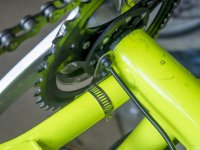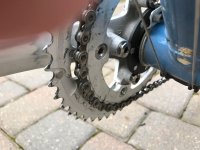majornelson
100 W
Long time member here... I'm trying to re-solve my PAS options. What I'm looking for is the best peddle-assistance solution for a road bike.
My goal has been to create a peddle-assist road bike using a Q100CST (cassette version) that would give me a boast while, at the same time, pedaling as I am a traditional road-biker. Just looking for a little extra as I go down the road. I have built a number of electric bikes that I love but this one is different.
I'm stuck. I'm trying to build a great road bike with peddle assist, modest battery and weight, with decent range and slightly higher speeds than I would otherwise have with traditional road bikes.
I have a 7 ah battery and a Q100CST wheel (700C) that I want to add it to a traditional road bike using PAS. I have several donor road bikes (all steel frame) that range from a 1983 Schwinn le tour luxe to a 20013 Rivbike Homer. I tried initially to use the Rivbike but I'm having trouble getting the PAS sensor to fit to the bottom bracket. Basically, I need a 4 mm gap to fit the PAS sensor magnetic wheel. Most of the new and old frames don't have that level of clearance.
I have a couple of bikes that I built that are throttle mode but for this one I really want peddle assist only. My challenge is that I can't fit the traditional cadence based sensors from greenbikekit sine wave controller in my bottom bracket/crankset. The space is too narrow. For the Rivbike, I replaced the BB (going from 107mm to 113.5mm) but the chainline was off. The chain kept jumping to lower gears if I back-pedaled it (which my LBS suggested as a test). Not good...
I've looked at upgrading to a Thun sensor and CA3 or sticking with my greenbikekit.com sine wave controller and display. I'm stuck...
Any suggestions or ideas appreciate!
Lee
My goal has been to create a peddle-assist road bike using a Q100CST (cassette version) that would give me a boast while, at the same time, pedaling as I am a traditional road-biker. Just looking for a little extra as I go down the road. I have built a number of electric bikes that I love but this one is different.
I'm stuck. I'm trying to build a great road bike with peddle assist, modest battery and weight, with decent range and slightly higher speeds than I would otherwise have with traditional road bikes.
I have a 7 ah battery and a Q100CST wheel (700C) that I want to add it to a traditional road bike using PAS. I have several donor road bikes (all steel frame) that range from a 1983 Schwinn le tour luxe to a 20013 Rivbike Homer. I tried initially to use the Rivbike but I'm having trouble getting the PAS sensor to fit to the bottom bracket. Basically, I need a 4 mm gap to fit the PAS sensor magnetic wheel. Most of the new and old frames don't have that level of clearance.
I have a couple of bikes that I built that are throttle mode but for this one I really want peddle assist only. My challenge is that I can't fit the traditional cadence based sensors from greenbikekit sine wave controller in my bottom bracket/crankset. The space is too narrow. For the Rivbike, I replaced the BB (going from 107mm to 113.5mm) but the chainline was off. The chain kept jumping to lower gears if I back-pedaled it (which my LBS suggested as a test). Not good...
I've looked at upgrading to a Thun sensor and CA3 or sticking with my greenbikekit.com sine wave controller and display. I'm stuck...
Any suggestions or ideas appreciate!
Lee






